Folk costumes
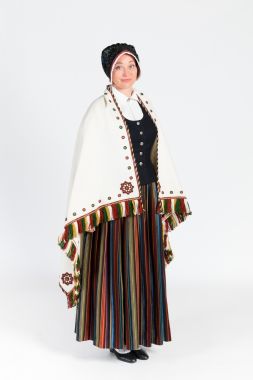
Women’s Clothing from Talsi
• Krekls – taisna piegriezuma garš (līdz puslielam) ar baltu izšuvumu un atlokāmu apkakli;• Brunči – jostasvietā ielocēs salikti kupli, vertikāli svītraina auduma brunči;• Veste – tumšas krāsas, pieguloša, bez rotājuma;• Villaine – balta, ar nelielu izšūtu saulītes motīva rotājumu stūros un mestām bārkstīm galos; • Galvassega – smalka žakarda auduma cepure:• Kāju āvums – adītas garas (līdz celim) rakstaini adītas zeķes;• Rotas – krekla aizdarei lieto vienu nelielu baltmetāla saktiņu.
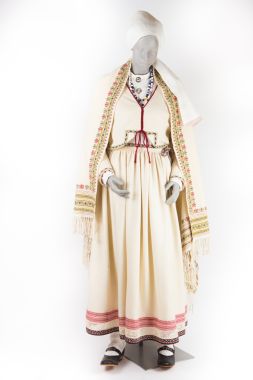
Women’s Clothing from Northern Latgale
Women’s clothing of the Northern Latgale district was characterized by a straight cut, mid-calf length linen fabric shirt, made of separate, rectangular fabric segments or a tunic-type shirt where the front and back are made of one contiguous piece of fabric folded over at the shoulders. The body of the shirt was woven in a diamond twill pattern, differing from the plain weave of the rest of the shirt. The shirt has stitched-on shoulder straps and red embroidery on the turnover collar, shoulder straps, and cuffs. The red embellishment on the shoulder straps was woven. The shirt was fastened with a small to medium sized silver annular brooch (sakta) or fabric ribbon.
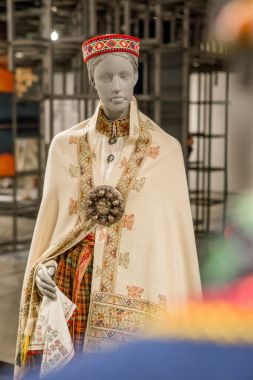
Women’s Clothing from Krustpils
The women’s clothing from the Krustpils district of the province of Vidzeme is characterized by a mid-calf length, linen shirt made either of two separate, rectangular fabric segments, or a one-piece body, where the front and back consist of one contiguous piece of fabric folded over at the shoulders. Multi-coloured embroidery is worked on the stand-up collar, shoulder straps, and the ends of the sleeves. The shirt is fastened with a small to medium size silver annular brooch (sakta), which may be set with polished glass stones.
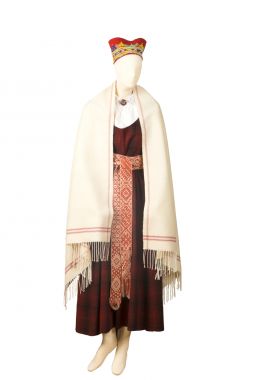
Women’s Clothing from Lielvārde
Women’s clothing from the Lielvārde district of the provide of Vidzeme is characterized by a long, mid-calf length linen shirt in one of two styles. One style consists of separate, rectangular fabric pieces sewn together at the shoulders, while the other is a tunic-style, where the front and back are made of one contiguous piece of fabric folded over at the shoulders. The shirt is fastened with a small to medium size silver or bronze annular brooch (sakta), set with polished glass stones.
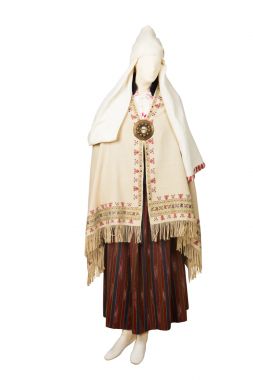
Women’s Clothing from Augšzeme / Selonia
The women’s clothing from Augšzeme is characterized by a long, mid-calf linen shirt made of separate, rectangular fabric segments stitched at the shoulders or a tunic-type shirt where the front and back are made of one contiguous piece of fabric folded over at the shoulders. There are two types of shoulder constructions, one where the shoulder straps are on the inside of the shirt and another with them sewn on the outside over the shoulder seam or fold. These are also embroidered in different ways. The shirts with straps inside had multi-coloured embroidery on the collars and cuffs, while the shirts with straps outside had red and white embroidery on the foldover collar, the shoulder straps, and the sleeves. The shirt is fastened with a small to medium size silver annular brooch (sakta) or red and white patterned fabric ribbon.
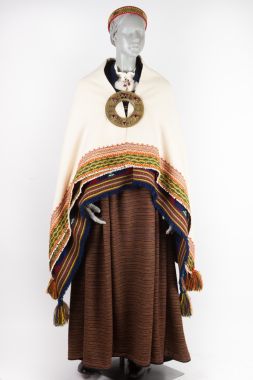
Women’s Clothing from Ventspils
Women’s clothing from the Ventspils district in the province of Kurzeme is characterized by linen shirts in one of two styles, either two separate, rectangular fabric pieces sewn together at the shoulders, while the other has a one piece body, where the front and back consist of one contiguous piece of fabric folded over at the shoulders. The shirt has an upright collar and whitework embroidery on the collar, shoulder straps, and cuffs, fastened with small to medium size annular brooches (saktas) or fabric ribbons.
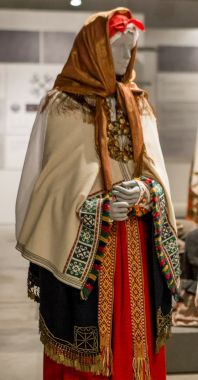
Women’s Clothing from Alsunga
Women’s clothing from Alsunga is characterized by a long, mid-calf length linen shirt in one of two styles. One style consists of separate, rectangular fabric pieces sewn together at the shoulders, while the other has a one piece body, where the front and back consist of one contiguous piece of fabric folded over at the shoulders. The shirt has a detachable collar and wide cuffs. The collar is embroidered with dark blue yarn or glass beads. The cuffs are embroidered with white or unbleached linen thread; alternatively with multi-coloured yarn. The shirt is fastened with a small to medium size sakta, set with polished glass stones.
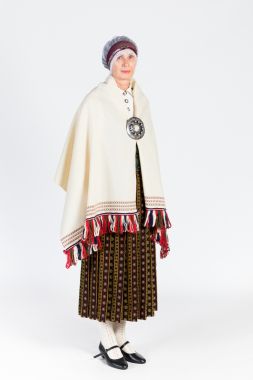
Married Women’s Clothing from Zemgale
Zemgales novada sievas tautastērps - Gitas Andersones mantojums.
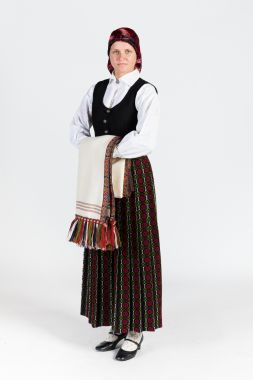
Women’s Clothing from Zemgale
Zemgale is located in Southern Latvia. It was once populated by the ancient Zemgalians who settled around the Lielupe River and its tributaries. In the nineteenth century, Zemgale consisted of the districts of Bauska and Jelgava, part of Eastern Tukums and the Rīga parishes on the left bank of the Daugava, which are now part of Vidzeme, even though economically and culturally they had closer ties with Zemgale. Because there are relatively few surviving articles of clothing from here, this area is not subdivided further. Even so, differences can be observed between the eastern and western areas. Traditional clothing here was shaped by the area’s affluence, well-developed agricultural, manufacturing, and trade sectors.